August 9, 2006
Catalina 309 Review: Cruising World Website – A Collaborative Compact Cruiser
How the heck do you replace an icon? Innovate.
by Jeremy McGeary
Billy Black
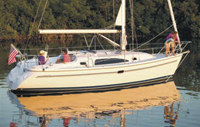 A molded transom step is one of the many differences between the Catalina 309 and the popular 30.
A molded transom step is one of the many differences between the Catalina 309 and the popular 30.
What to do to upstage a tried-and-true cruiser? That was the question facing the management at Catalina Yachts when they at last concluded that after 30 years of production, the Catalina 30 had run its course.
The simple answer-to design and build a new 30-was complicated by the presence of 7,000 of the old models. Whatever filled the slot had to be seductive enough to tempt buyers away from a marketplace full of pre-owned boats at attractive prices.
 Gerry Douglas, Catalina’s vice president and designer, says coming up with the basic design brief wasn’t hard. It wasn’t very different from its predecessor’s: a simple family cruising boat that’s fun to sail and has potential for low-key racing for owners so inclined. But he did agonize over how the boat should look. Should he stay with Catalina’s proven but conservative styling or try to add a little dash?
Gerry Douglas, Catalina’s vice president and designer, says coming up with the basic design brief wasn’t hard. It wasn’t very different from its predecessor’s: a simple family cruising boat that’s fun to sail and has potential for low-key racing for owners so inclined. But he did agonize over how the boat should look. Should he stay with Catalina’s proven but conservative styling or try to add a little dash?
He’s succeeded in doing both. The Catalina 309 sports conventional proportions of hull, coachroof, and cockpit profile set off by contemporary half-bullet-shaped cabin-trunk portlights. Also contemporary is the broad beam aft, and Douglas has softened its visual impact by carefully sculpting seats and a boarding step into the transom.
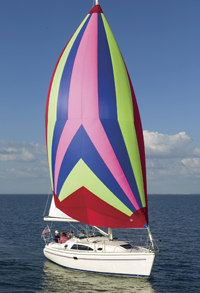 Another challenge was to fit the best possible equipment without busting the boat’s necessarily tight budget; to help do that, Catalina asked its vendors for creative solutions.
Another challenge was to fit the best possible equipment without busting the boat’s necessarily tight budget; to help do that, Catalina asked its vendors for creative solutions.
Edson responded with a tidy steering console that arrives at the Catalina plant assembled and prewired and requires six bolts to secure to the cockpit sole. The steering system is designed so that it barely intrudes below the cockpit sole, making the berth beneath truly usable by a couple.
Garhauer crafted a ball-bearing mainsheet traveler on which both control lines exit via sheaves under the track on the port side and lead cleanly to the cockpit.
Lewmar manufactured a new winch, a model 34, for the 309’s primaries because the needed capacity fell between its existing 30 and 40 models.
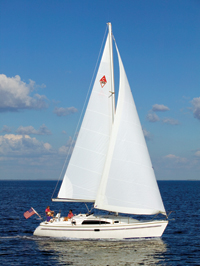 Catalina itself looked hard at its production methods. It changed the hull/deck joint at the stern to run it across the top of the transom and around the transom opening. This removed it from the transom/ hull perimeter, which is difficult to seal on the inside and is vulnerable to damage. A plate at the top of the compression post for the deck-stepped mast butts the step plate, so there’s metal-to-metal contact from the butt of the mast right down to the keel, eliminating a prime source of old-boat maintenance woes. The mast wiring passes through a swan-neck standpipe to prevent water ingress. The chainplates, too, are new, with ball-and-socket joints belowdecks connecting to tie-rods, which lead to an aluminum channel laminated to the hull-liner pan behind furniture in the saloon and head.
Catalina itself looked hard at its production methods. It changed the hull/deck joint at the stern to run it across the top of the transom and around the transom opening. This removed it from the transom/ hull perimeter, which is difficult to seal on the inside and is vulnerable to damage. A plate at the top of the compression post for the deck-stepped mast butts the step plate, so there’s metal-to-metal contact from the butt of the mast right down to the keel, eliminating a prime source of old-boat maintenance woes. The mast wiring passes through a swan-neck standpipe to prevent water ingress. The chainplates, too, are new, with ball-and-socket joints belowdecks connecting to tie-rods, which lead to an aluminum channel laminated to the hull-liner pan behind furniture in the saloon and head.
One effect of the boat’s broad beam is immediately apparent on boarding. The cockpit is generous in its proportions, and the steering console and integral table serve as foot braces. The bimini looks large, but this could be a symptom of early-hull-number syndrome-an artful dodger maker could no doubt sweeten its appearance.
 Other than being wider, which translates into more elbowroom, the arrangement belowdecks isn’t so different from the original 30. The biggest gain is in the aft cabin, on the starboard side, where a double berth fits under the cockpit. To port, the galley has picked up some counter space and storage. It’s also fitted with a Coolmate refrigeration unit that automatically switches from 12 volts DC to 110 volts AC when shore power is available. Opposite the galley is a small, aft-facing chart table served by the aft end of the starboard settee. The switch panel, which employs automotive-type fuses instead of circuit breakers, is mounted on the outboard partition, with space above it and on the aft-cabin bulkhead for nav gadgets.
Other than being wider, which translates into more elbowroom, the arrangement belowdecks isn’t so different from the original 30. The biggest gain is in the aft cabin, on the starboard side, where a double berth fits under the cockpit. To port, the galley has picked up some counter space and storage. It’s also fitted with a Coolmate refrigeration unit that automatically switches from 12 volts DC to 110 volts AC when shore power is available. Opposite the galley is a small, aft-facing chart table served by the aft end of the starboard settee. The switch panel, which employs automotive-type fuses instead of circuit breakers, is mounted on the outboard partition, with space above it and on the aft-cabin bulkhead for nav gadgets.
 Forward, the V-berth expands to a double via a sliding filler panel, and just aft and to port is the perfectly adequate head. On the starboard side, a low hanging locker topped with a broad, fiddled shelf contributes to the saloon’s openness.
Forward, the V-berth expands to a double via a sliding filler panel, and just aft and to port is the perfectly adequate head. On the starboard side, a low hanging locker topped with a broad, fiddled shelf contributes to the saloon’s openness.
In the saloon, the center of the starboard settee’s backrest flips down for a beverage/book/game table. The dining table is to port, next to the L-shaped settee, and stows in the aft cabin. A large, hinged table leaf opens to meet the starboard settee. Five can sit around it in comfort. A sixth might need to bring a folding chair from the vast cockpit locker, because Douglas has shortened the L of the dinette, which on the 30 extended over the engine box. On the 309, the engine lives under a removable box that supports the companionway steps, making it totally accessible.
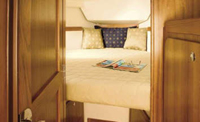 Unornamented, teak-veneered joiner panels decorated only by their grain and minimal teak trim set the traditional ambience, abetted by the “teak-and-holly” cabin sole, which is, in fact, a colored, synthetic laminate glued into recesses in the fiberglass floor pan-another vendor-supplied solution. The whole interior, assembled in customary Catalina fashion in the fiberglass liner pan, promises to be comfortable and easy to maintain, and needs the addition only of a clock and barometer set, a few books, and some well-thumbed copies of Cruising World to make it a cozy getaway.
Unornamented, teak-veneered joiner panels decorated only by their grain and minimal teak trim set the traditional ambience, abetted by the “teak-and-holly” cabin sole, which is, in fact, a colored, synthetic laminate glued into recesses in the fiberglass floor pan-another vendor-supplied solution. The whole interior, assembled in customary Catalina fashion in the fiberglass liner pan, promises to be comfortable and easy to maintain, and needs the addition only of a clock and barometer set, a few books, and some well-thumbed copies of Cruising World to make it a cozy getaway.
My host for the test run last February was Ron Frisosky, the southeast regional rep for Catalina Yachts who’s served both builder and dealers for decades. We set off from Miami’s Bayside Marina and motored out to Government Cut.
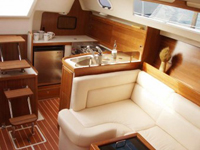 We’d just begun to settle in when photographer Billy Black zoomed up. “Lookin’ good!” he called over. “But can you tighten up the jib halyard?” Ron fiddled with it some, but once Billy was gone, we decided to tighten it more. I eased the jib sheet so the sail was partially luffing, and we led the halyard back to the cockpit winch, cranked it up a bit, and reset the jammer on the mast. All the while, with the main drawing and the wheel locked, the boat happily reached steadily along. Even after I trimmed in the jib, it just kept on course, untended, for about 10 minutes. That’s the kind of forgiving behavior I like to see in a cruising boat.
We’d just begun to settle in when photographer Billy Black zoomed up. “Lookin’ good!” he called over. “But can you tighten up the jib halyard?” Ron fiddled with it some, but once Billy was gone, we decided to tighten it more. I eased the jib sheet so the sail was partially luffing, and we led the halyard back to the cockpit winch, cranked it up a bit, and reset the jammer on the mast. All the while, with the main drawing and the wheel locked, the boat happily reached steadily along. Even after I trimmed in the jib, it just kept on course, untended, for about 10 minutes. That’s the kind of forgiving behavior I like to see in a cruising boat.
This all took place in a nice sailing breeze of maybe 10 to 12 knots and a light chop. The speedo transducer wasn’t installed, but my eyeball-over-the-transom technique suggested a solid 5 to 6 knots. If time had permitted, we’d have had a lovely and quick sail down to Cape Florida with the boat tacking happily through 90 degrees even with the shoal-draft wing keel. I’d have wished to sail in a little more bluster, but for the conditions of that day, Douglas, in his role as sailboat designer, seems to have hit the sweet spot.
